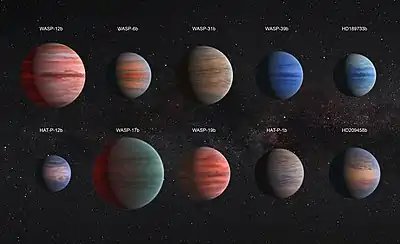HAT-P-12b
HAT-P-12b is an extrasolar planet approximately 468 light years away from Earth, orbiting the 13th magnitude K-type star HAT-P-12, which is located in Canes Venatici constellation. It is a transiting hot Jupiter that was discovered by the HATNet Project on April 29, 2009.
 Size comparison of HAT-P-12b with Jupiter. | |
| Discovery | |
|---|---|
| Discovered by | Hartman et al. |
| Discovery site | Cambridge, Massachusetts |
| Discovery date | April 29, 2009 |
| Transit | |
| Orbital characteristics | |
| 0.0384 ± 0.0003 AU (5,745,000 ± 45,000 km)[1] | |
| Eccentricity | 0 (assumed)[1] |
| 3.2130598 ± 0.0000021[1] d | |
| Inclination | 89.0 ± 0.4[1] |
| Star | HAT-P-12 |
| Physical characteristics | |
Mean radius | 0.959 ± 0.029[1] RJ |
| Mass | 0.211 ± 0.012[1] MJ |
Mean density | 295 ± 25 kg/m3 (497 ± 42 lb/cu yd)[1] |
HAT-P-12b is a H/He-dominated gas giant planet with a core mass of 11.3+2.6
−2.1 M⊕ and is moderately irradiated by its low-metallicity host star.[2] Therefore, HAT-P-12b is most likely an H/He-dominated planet with a core of perhaps ~10 M⊕, and a total metal fraction of ~15%. This makes HAT-P-12b the least massive H/He-dominated gas giant planet found to date; the previous record holder was Saturn.[1]

From top left to lower right: WASP-12b, WASP-6b, WASP-31b, WASP-39b, HD 189733b, HAT-P-12b, WASP-17b, WASP-19b, HAT-P-1b and HD 209458b.
In 2020, the obtained transmission spectra have revealed that the atmosphere of HAT-P-12b is cloudy,[3] with haze above cloud tops. Water was detected.[4]
References
- Hartman, J. D.; et al. (2009). "HAT-P-12b: A Low-density sub-Saturn mass planet transiting a metal-poor K dwarf". The Astrophysical Journal. 706 (1): 785–796. arXiv:0904.4704. Bibcode:2009ApJ...706..785H. doi:10.1088/0004-637X/706/1/785. S2CID 14540643.
- Lee, Jae Woo; Youn, Jae-Hyuck; Kim, Seung-Lee; Lee, Chung-Uk; Hinse, Tobias Cornelius (2012). "THE SUB-SATURN MASS TRANSITING PLANET HAT-P-12b". The Astronomical Journal. 143 (4): 95. arXiv:1201.6419. Bibcode:2012AJ....143...95L. doi:10.1088/0004-6256/143/4/95. S2CID 118610109.
- Yan, F.; Espinoza, N.; Molaverdikhani, K.; Henning, Th.; Mancini, L.; Mallonn, M.; Rackham, B. V.; Apai, D.; Jordán, A.; Mollière, P.; Chen, G.; Carone, L.; Reiners, A. (2020), "LBT transmission spectroscopy of HAT-P-12b: confirmation of a cloudy atmosphere with no significant alkali features", Astronomy & Astrophysics, A98: 642, arXiv:2007.15485, doi:10.1051/0004-6361/201937265, S2CID 220870755
- Wong, Ian; Benneke, Björn; Gao, Peter; Knutson, Heather A.; Chachan, Yayaati; Henry, Gregory W.; Deming, Drake; Kataria, Tiffany; Lee, Graham K. H.; Nikolov, Nikolay; Sing, David K.; Ballester, Gilda E.; Baskin, Nathaniel J.; Wakeford, Hannah R.; Williamson, Michael H. (2020). "Optical to near-infrared transmission spectrum of the warm sub-Saturn HAT-P-12b". The Astronomical Journal. 159 (5): 234. arXiv:2004.03551. doi:10.3847/1538-3881/ab880d. S2CID 215238620.